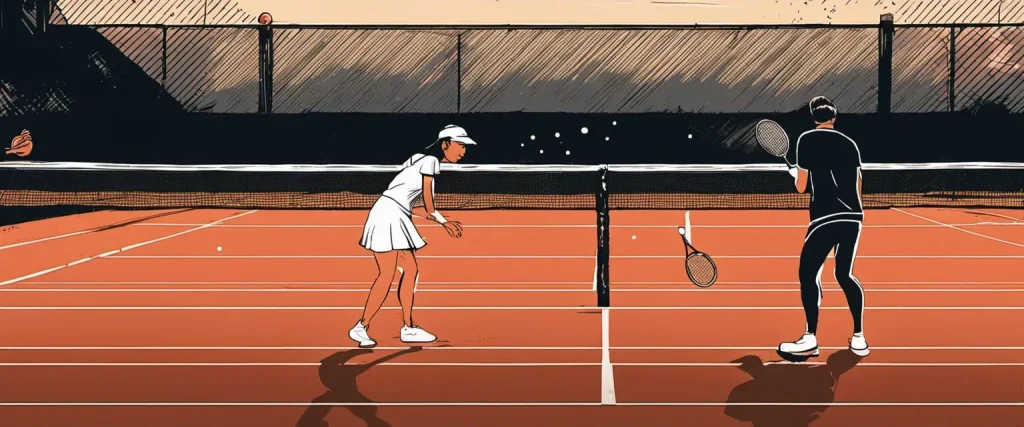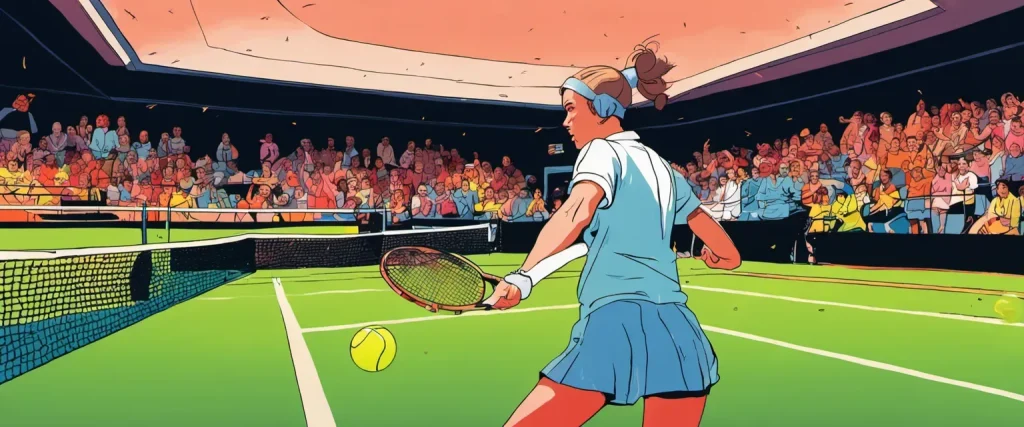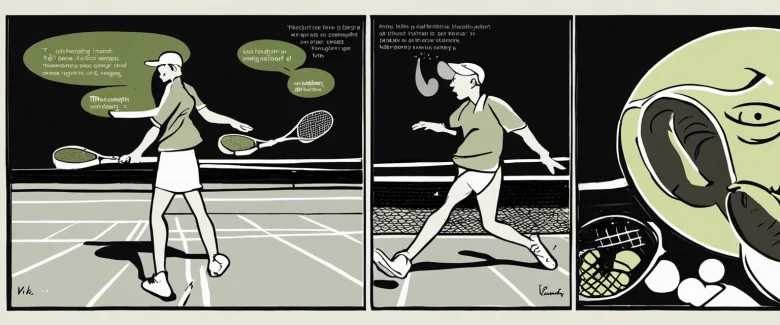In “The Inner Game of Tennis,” W. Timothy Gallwey skillfully explores the interplay between the physical and mental aspects of the game, highlighting the profound impact of our inner thoughts and beliefs on our performance. Gallwey, a former Harvard University tennis player and coach, has gone on to become a renowned sports psychologist and an influential figure in the field of coaching. With his unique approach, he unveils the secrets to unlocking one’s true potential in tennis and beyond.
Chapter 1: Introduction
Chapter 1 of “The Inner Game of Tennis” by W. Timothy Gallwey lays the foundation for the exploration of the inner game in sports. Gallwey introduces the concept of the two selves within every individual: Self 1, the conscious mind or “tell and do” self, and Self 2, the unconscious mind or “learn and play” self.
Gallwey argues that the key to improving performance lies in quieting Self 1’s judgmental and instructive tendencies, allowing Self 2’s natural ability to emerge. He demonstrates how players often become hindered by overthinking, self-criticism, and interference from their conscious minds. These mental obstacles disrupt the fluidity and instinctual nature of performance, interfering with the player’s true potential.
The author illustrates this concept through an anecdote about a tennis lesson. He describes a student, Tom, who exhibits significant improvement in his shots when he is not consciously focusing on his technique. When Tom is instructed to “just watch the ball and hit it,” his strokes become effortless and powerful. Gallwey emphasizes the importance of letting go of conscious control and allowing the unconscious mind to guide movements effectively.
As the chapter progresses, Gallwey highlights the importance of awareness, stating that direct observation without judgment is necessary for overcoming the internal barriers that inhibit performance. This process involves quieting the conscious mind’s constant stream of thought and allowing the natural instincts and reflexes of Self 2 to take over.
Overall, Chapter 1 of “The Inner Game of Tennis” sets the stage for the exploration of the relationship between the two selves and the significance of harnessing the power of the subconscious mind to enhance sports performance. It lays the groundwork for a deeper understanding of the mental game within tennis and beyond.
Chapter 2: The Inner and Outer Game
Chapter 2 of The Inner Game of Tennis by W. Timothy Gallwey delves into the concept of the “inner game” and its relationship with the “outer game” of tennis. Gallwey explains that the inner game refers to the mental and psychological aspects of tennis, while the outer game focuses on the physical skills and techniques.
The chapter begins by emphasizing the importance of balance between the inner and outer game. Gallwey suggests that in traditional teaching methods, too much emphasis is placed on the outer game, leading to players relying solely on technical instructions rather than cultivating their own natural abilities. Instead, Gallwey argues for a greater understanding and awareness of the inner game, which involves quieting the mind and allowing intuition to guide one’s movements.
The author introduces the concept of Self 1 and Self 2 to explain the inner game further. Self 1 represents the conscious, judgmental mind that criticizes and instructs, often leading to overthinking and self-doubt. Self 2, on the other hand, represents the unconscious, intuitive mind that possesses natural talent and can perform effortlessly when given the chance.
Gallwey suggests that the key to improving one’s game lies in trusting Self 2 and allowing it to take over during matches. By letting go of self-criticism and analysis, players can tap into their innate abilities and achieve a state of “relaxed concentration.” This state allows for improved focus, fluid movement, and heightened performance.
In summary, Chapter 2 of The Inner Game of Tennis explores the relationship between the inner and outer game of tennis. It emphasizes the need to balance technical skills with mental clarity and intuition. By quieting the conscious mind and trusting in natural abilities, players can reach a state of optimal performance and enjoyment in the game.
Chapter 3: Self 1 and Self 2
Chapter 3 of “The Inner Game of Tennis” by W. Timothy Gallwey introduces the concept of Self 1 and Self 2, which represent two different aspects of our mental faculty while playing tennis or engaging in any other activity. Self 1 represents the conscious, analytical, and judgmental mind, while Self 2 is the non-judgmental, intuitive, and instinctive mind.
Gallwey suggests that Self 1 often interferes with our performance because it constantly evaluates and criticizes our actions, causing self-doubt and anxiety. Self 1 tends to give instructions to the body and tries to control every movement consciously. However, this leads to overthinking and inhibits the natural ability of Self 2 to perform.
On the other hand, Self 2 is capable of learning and executing tasks effortlessly through direct experience. It functions without relying on conscious instruction and carries out tasks using feel and intuition. Gallwey emphasizes the importance of quieting Self 1 to allow Self 2 to take over and perform at its best.
To demonstrate the power of Self 2, Gallwey provides an exercise where he asks readers to hit tennis balls with loose hands, focusing solely on watching the ball and allowing the body to respond instinctively. Most readers experience a significant improvement in their shots by quieting the controlling tendencies of Self 1 and letting Self 2 guide their actions.
Overall, the chapter highlights the need to trust and engage the non-judgmental and intuitive mind of Self 2, rather than allowing the conscious and critical mind of Self 1 to hinder performance in sports or any other activity.
Chapter 4: Awareness and Attention

Chapter 4 of “The Inner Game of Tennis” by W. Timothy Gallwey focuses on the concepts of awareness and attention in tennis. Gallwey argues that the key to improving one’s performance lies in developing a heightened sense of awareness and attention on the tennis court.
Gallwey explains that awareness is the ability to observe without judgment, allowing players to see things as they truly are. He asserts that many players create unnecessary mental distractions by constantly analyzing their technique or evaluating their performance, which hinders their ability to concentrate and respond effectively on the court. By cultivating a non-judgmental awareness, players can free themselves from such distractions and focus on the present moment.
Gallwey also emphasizes the importance of attention, stating that the ideal state of attention is when there is an unbroken connection between the body and the mind. He advises players to focus their attention on the ball and its movement, rather than being preoccupied with thoughts about winning or losing. By keeping their attention in the present moment, players can anticipate and react to the ball more effectively.
The chapter also delves into the idea of critical self-observation and the negative impact it can have on performance. Gallwey suggests that players should replace self-criticism with constructive observation, which allows them to objectively identify areas for improvement without damaging their self-confidence.
Overall, Chapter 4 highlights the significance of awareness and attention in the practice of tennis. By developing a non-judgmental awareness, maintaining focus and attention on the present moment, and cultivating constructive observation, players can enhance their performance and find more enjoyment in the game.
Chapter 5: Letting Go of Judgment
Chapter 5 of “The Inner Game of Tennis” by W. Timothy Gallwey is titled “Letting Go of Judgment.” In this chapter, the author explores the negative impact of judgment on a player’s performance and introduces techniques for overcoming it.
Gallwey begins by highlighting the common tendency of tennis players to judge themselves harshly, focusing on mistakes rather than the positive aspects of their game. He explains that this judgmental mindset creates a mental block that hinders their true potential. This constant self-criticism leads to doubt, anxiety, and a loss of confidence, all of which interfere with the player’s ability to perform at their best.
To address this issue, Gallwey introduces the concept of “concentration without judgment.” He encourages readers to observe their actions and responses on the court without attaching negative evaluations or labels such as “good” or “bad.” This shift in focus helps players become more aware of their game and enables them to make objective assessments rather than judgments.
The author also introduces the idea of separating the learning process from the performance mode. He highlights that during practice, players should focus on experimenting, learning, and refining their technique without any concern for judgment or evaluation. By doing so, players can develop their skills without the fear of failure or the pressure to perform perfectly.
Gallwey emphasizes the role of trust and self-acceptance in overcoming judgment. He explains that by cultivating trust in their abilities and accepting themselves unconditionally, players can let go of the need for judgment and focus solely on the present moment.
In conclusion, Chapter 5 emphasizes the detrimental effects of judgment on a player’s performance and provides strategies for overcoming this mindset. By practicing concentration without judgment, separating learning from performance, and cultivating trust and self-acceptance, players can unlock their full potential and achieve a more positive and fulfilling tennis experience.
Chapter 6: Concentration and Focus
Chapter 6 of “The Inner Game of Tennis” by W. Timothy Gallwey focuses on concentration and focus, two key elements in developing a strong mental game in tennis. It explores various techniques and strategies to improve one’s ability to concentrate and maintain a focused state during a match.
Gallwey begins by highlighting the importance of being present in the moment and fully engaged in the task at hand. He emphasizes the notion of being “here and now,” where thoughts about past or future events are unproductive distractions. The author also emphasizes the need for a shift in perspective, encouraging players to perceive practice sessions and matches as opportunities for learning and self-improvement rather than simply a means to reach a desired outcome.
Gallwey introduces the concept of the “self 1” and “self 2” dichotomy, which refers to the internal dialogue that occurs within a player’s mind during a game. Self 1 represents the analytical and judgmental part of the mind, while self 2 represents the natural and instinctive part. The author advises players to quieten self 1 and trust self 2 by engaging in a more intuitive and relaxed style of play.
To further aid concentration, Gallwey suggests employing focused external cues, such as watching the ball or choosing a target spot on the court to aim for. By directing attention to specific sensory cues, players are better able to block out distractions and stay present in the moment.
Gallwey also stresses the importance of developing a non-judgmental awareness of mistakes and errors. By reframing mistakes as learning opportunities rather than failures, players can refocus their attention on the present moment rather than dwelling on past mistakes. This mindset enables players to move forward and make more productive decisions during matches.
In conclusion, Chapter 6 of “The Inner Game of Tennis” provides practical techniques for improving concentration and focus in tennis. By cultivating a present-centered approach, reducing judgmental self-talk, and developing a more intuitive playing style, players can enhance their mental game and perform at their best on the court.
Chapter 7: Learning and Performance
Chapter 7 of “The Inner Game of Tennis” by W. Timothy Gallwey explores the relationship between learning and performance in the game of tennis. The chapter begins by emphasizing the importance of focusing on the process of learning rather than worrying about the outcome or performance results.
Gallwey describes the concept of “The Inner Game Triangle” which consists of three components: Self 1 (the analytical mind or the conscious self), Self 2 (the non-judgmental and instinctual self), and the Ideal Performance State (IPS). He explains that the purpose of learning is not to enhance Self 1’s control over Self 2, but to allow Self 2 to perform naturally and instinctively, effortlessly tapping into one’s true potential.
The author introduces the idea of “judgmentalism,” which involves the constant comparison of oneself against a set of standards or goals. He argues that this self-critical mindset hinders learning and performance, as it creates anxiety and self-doubt. Instead, he suggests adopting a non-judgmental mindset that focuses on observing and accepting one’s current abilities without labeling them as good or bad.
Gallwey introduces various techniques to enhance learning and performance, including the concept of “the natural learning process.” This involves observing, visualizing, and feeling the desired outcome or technique, without getting overly attached to the final result. He also emphasizes the importance of building a strong foundation of fundamentals and practicing with mindfulness and awareness.
In summary, Chapter 7 of “The Inner Game of Tennis” highlights the significance of focusing on the learning process rather than fixating on performance outcomes. It encourages readers to adopt a non-judgmental mindset and cultivate the natural learning process to achieve optimal performance on the tennis court.

Chapter 8: Transcending the Inner Game
Chapter 8 of “The Inner Game of Tennis” by W. Timothy Gallwey is titled “Transcending the Inner Game” and focuses on achieving a state of “non-judgmental awareness” in tennis and in life.
Gallwey begins by discussing the importance of being fully present in the moment and avoiding the distractions of the past or future. He emphasizes the concept of “seeing the ball,” which involves letting go of excessive thinking and allowing the body to instinctively respond to the ball’s movement. This state of focused attention is essential to perform at one’s best.
Furthermore, Gallwey explores the tendency to judge oneself and others, emphasizing that this mindset leads to self-doubt, anxiety, and hindered performance. Instead, he encourages readers to adopt a non-judgmental mindset, allowing themselves and others to make mistakes without negatively affecting their self-esteem or confidence.
The author also discusses the idea of “letting it happen” rather than trying to make it happen. By trusting in the body’s natural abilities and allowing it to function without unnecessary interference from the conscious mind, players can tap into their true potential. This approach reduces unnecessary thinking and brings about a calm and quiet state of mind.
Gallwey suggests practicing meditation or mindfulness to cultivate this mindset of non-judgmental awareness. By consistently practicing these techniques, players can develop their mental strength and enhance their overall performance on the tennis court.
In summary, Chapter 8 of “The Inner Game of Tennis” focuses on transcending the inner game by achieving a state of non-judgmental awareness. By being fully present in the moment, letting go of excessive thinking, and trusting in the body’s natural abilities, players can tap into their true potential and experience enhanced performance on and off the tennis court.
After Reading
In conclusion, “The Inner Game of Tennis” by W. Timothy Gallwey is a groundbreaking book that delves into the psychological aspects of athletic performance. Gallwey challenges conventional teachings by highlighting the inner dialogue and mental barriers that hinder players from reaching their full potential. By focusing on self-awareness, mindfulness, and learning from experience, Gallwey offers practical strategies to overcome these obstacles and unlock one’s true potential in tennis and beyond. This book serves as a valuable resource for athletes, coaches, and individuals seeking to enhance their mental game and improve overall performance.
1. Late Bloomers” by Rich Karlgaard: This inspiring book explores the power of embracing one’s unique path and challenges the notion that success is limited to early achievers. Rich Karlgaard shares the stories of individuals who achieved remarkable success later in life, demonstrating that it’s never too late to bloom.
2. Can’t Hurt Me” by David Goggins: In this raw and captivating memoir, David Goggins shares his incredible journey from a troubled childhood to becoming one of the toughest endurance athletes and Navy SEALs. Goggins explores the power of the mind to overcome obstacles, pushing readers to redefine their own limits and tap into their hidden potential.
3. How to Live: A Life of Montaigne in One Question and Twenty Attempts at an Answer” by Sarah Bakewell: After delving into “The Inner Game of Tennis,” explore the life and philosophy of Michel de Montaigne through this thought-provoking biography. Bakewell offers an engaging exploration of Montaigne’s essays, presenting practical insights on living a meaningful life that are relevant even in today’s fast-paced world.
4. Atomic Habits” by James Clear: Building upon the principles of “The Inner Game of Tennis,” this transformative book by James Clear focuses on the power of small habits to create significant change. Clear provides practical strategies to build effective habits and break counterproductive ones, helping readers develop a strong mental framework for continuous growth and self-improvement.
5. The Brain That Changes Itself” by Norman Doidge: Expanding on the concept of neuroplasticity discussed in “The Inner Game of Tennis,” Norman Doidge delves into the remarkable ability of the brain to adapt and rewire itself throughout life. Through fascinating real-life stories, Doidge demonstrates how our thoughts and actions can shape our brains, opening up opportunities for personal transformation and growth.



